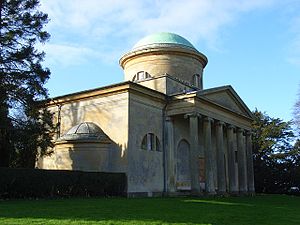- Old All Saints Church, Nuneham Courtenay
-
Old All Saints Church,
Nuneham Courtenay
Old All Saints Church, Nuneham CourtenayLocation in Oxfordshire Coordinates: 51°40′50″N 1°13′06″W / 51.6805°N 1.2182°W OS grid reference SU 542 983 Location Nuneham Courtenay, Oxfordshire Country England Denomination Anglican Website Churches Conservation Trust History Founder(s) Simon Harcourt, 1st Earl Harcourt Architecture Functional status Redundant Heritage designation Grade II* Designated 18 July 1963 Architect(s) Simon Harcourt, 1st Earl Harcourt with James Stuart Architectural type Church Style Neoclassical Completed 1764 Construction cost Over £800 Specifications Materials Limestone ashlar
Dome copper-coveredOld All Saints Church, Nuneham Courtenay, or Harcourt Chapel, is a redundant Anglican church near the village of Nuneham Courtenay, Oxfordshire, England. It has been designated by English Heritage as a Grade II* listed building,[1] and is under the care of the Churches Conservation Trust.[2] The church is sited to the southwest of the village, in the grounds of Nuneham House overlooking the River Thames, some 6 miles (10 km) southeast of Oxford.[2][3]
Contents
History
This church is the second of three parish churches serving Nuneham Courtenay, each of which was dedicated to All Saints. The original church dated from the medieval period but was in a "ruinous state" by 1762.[4] The medieval church was demolished by Simon Harcourt, 1st Earl Harcourt. The churchyard was destroyed and turned into a "pleasure ground" for the earl.[4] This church was built in 1764.[1] It was designed by the earl himself, with alterations to the design made by the architect James Stuart.[4] Its estimated cost was over £800 (£90,000 as of 2011).[5] The church was sited conveniently for the earl and his family, but not for the parishioners living in the village. In 1880 the third parish church was built, this time in the village, and this church (the subject of this article) was converted for use as a private chapel for the family and refurnished.[4] It was declared redundant on 8 May 1980, and was vested in the Churches Conservation Trust on 28 October 1981.[6] For visitor access, a key can be obtained from the Global Retreat Centre nearby.[2]
Architecture
Exterior
The church is constructed in limestone ashlar, and has a copper-covered dome.[1] Its design is said to be based on one of the temples of Palmyra.[4] The plan of the church is rectangular, with projections on each side. The principal front is the north front, which is said to resemble the entrance front of Chiswick House.[1] This has a projecting portico with six Ionic columns and a semicircular Diocletian window on each side of the portico. The portico is surmounted with an entablature consisting of a dentil cornice and a triangular pediment. The wall at the back of the portico contains a blind doorway and blind arches. The south front also has a pediment but this is enclosed. It has a central doorway with wrought iron gates. The east and west fronts are semicircular and are surmounted with half domes. The west front contains an entrance porch with Ionic columns. The main central dome contains four Diocletian windows. On the exterior of the east wall is a large memorial that was moved from the earlier church.[1]
Interior
The interior contains a central rotunda and two rectangular spaces. Around the rotunda are niches, and a there is a small baptistry to its south. On the walls are plaster panels containing texts. Along the walls are elaborately carved stalls that were introduced in 1880. These are in 16th-century Italian style; their backs are decorated with panels divided by Corinthian columns. The wooden lectern dates from the 17th or 18th century. The font is gadrooned and dates from 1843; it has an Italian cover in Baroque style. Also in the church are two chests, four hatchments from the 19th century, three tapestries, relics from the funeral of Edward VII, and monuments to the Harcourt family.[1]
See also
- List of churches preserved by the Churches Conservation Trust in South East England
References
- ^ a b c d e f "Church of All Saints, Nuneham Courtenay", The National Heritage List for England (English Heritage), 2011, http://list.english-heritage.org.uk/resultsingle.aspx?uid=1286134, retrieved 9 May 2011
- ^ a b c All Saints' Church, Nuneham Courtenay, Oxfordshire, Churches Conservation Trust, http://www.visitchurches.org.uk/Ourchurches/Completelistofchurches/All-Saints-Church-Nuneham-Courtenay-Oxfordshire/, retrieved 9 May 2011
- ^ Nuneham Courtenay, Streetmap, http://streetmap.co.uk/grid/454047_198311_120, retrieved 9 May 2011
- ^ a b c d e Lobel, Mary D., ed. (1957), "Parishes: Nuneham Courtenay", A History of the County of Oxford, Victoria County History (University of London & History of Parliament Trust) 5: pp. 234–249, http://www.british-history.ac.uk/report.aspx?compid=101894#s5, retrieved 9 May 2011
- ^ UK CPI inflation numbers based on data available from Lawrence H. Officer (2010) "What Were the UK Earnings and Prices Then?" MeasuringWorth.
- ^ (PDF) Diocese of Oxford: All Schemes, Church Commissioners/Statistics, Church of England, 2011, p. 6, http://www.churchofengland.org/media/810796/oxford%20-%20all%20schemes.pdf, retrieved 9 May 2011
Categories:- Grade II* listed buildings in Oxfordshire
- Grade II* listed churches
- Church of England churches in Oxfordshire
- Neoclassical architecture
- Churches preserved by the Churches Conservation Trust
- Religious buildings completed in 1764
Wikimedia Foundation. 2010.

